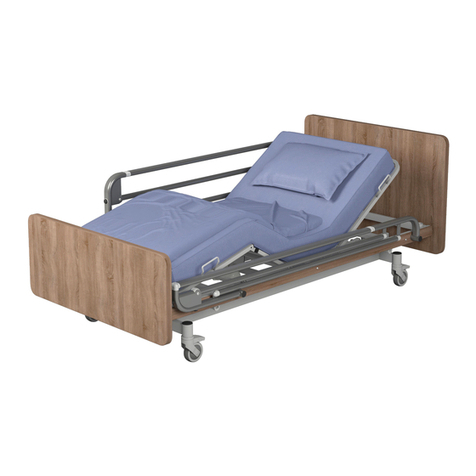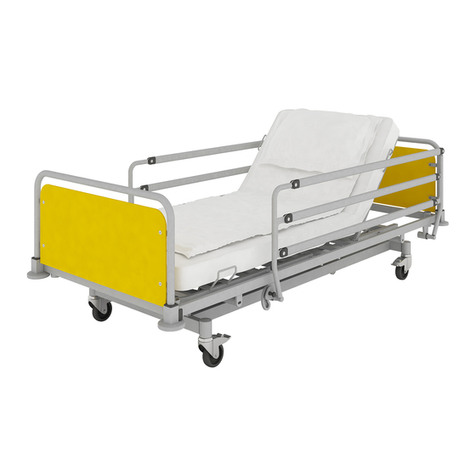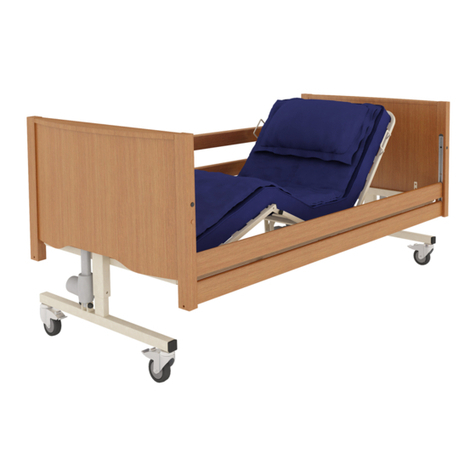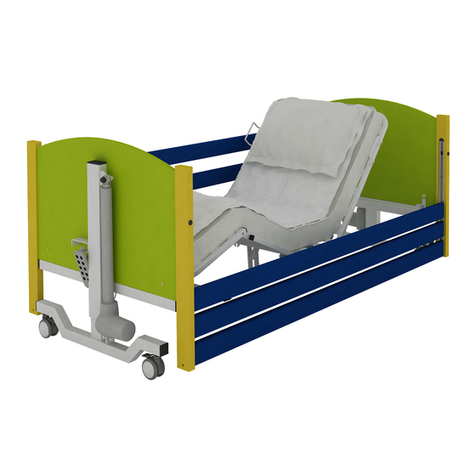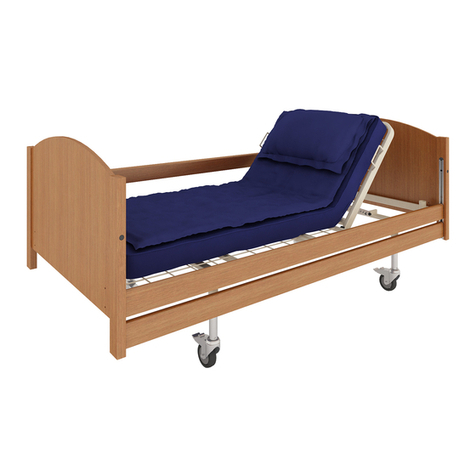3
Table of contents
1. INTRODUCTION......................................4
1.1. CONTACT .......................................... 4
1.2. WHAT THE INSTRUCTION MANUAL IS
ABOUT?.......................................................... 4
1.3. GENERAL INFORMATION....................... 5
1.4. APPLICATION...................................... 5
1.5. CONTRAINDICATIONS........................... 6
2. WARNINGS AND CAUTIONS ...................7
2.1. WARNINGS AND CAUTIONS................... 7
3. TRANSPORT AND STORAGE..................11
4. SYMBOLS AND MARKINGS ...................14
5. COMPONENT PARTS ............................16
5.1. LIST OF COMPONENTS OF THE BED ....... 16
6. ASSEMBLY OF THE BED AND
PREPARATION FOR USE ...........................17
6.1. DISASSEMBLY FROM THE TRANSPORT
STAND.......................................................... 17
6.2. ASSEMBLY OF THE BED ....................... 18
6.3. CONNECTION OF THE ELECTRICAL SYSTEM
................................................................... 19
6.4. ASSEMBLY OF WOODEN SIDE RAILS....... 22
6.4.1. SIDE RAILS AND MATTRESSES .... 25
6.4.2. SIDE RAIL SAFETY .................... 25
6.5. FITTING RATCHET.............................. 26
6.6. CHECKING THE BED............................ 27
7. TRAINING.............................................28
8. FIRST USE.............................................29
8.1. GENERAL SAFETY............................... 30
8.2. PREPARATION FOR COMMISSIONING .... 30
8.3. BRAKE SYSTEM ................................. 31
8.4. SIDE RAILS AND MATTRESS.................. 32
8.4.1. HEIGHT OF THE MATTRESS ........ 33
8.4.2. USE OF SIDE RAILS ................... 33
8.5. ELECTRICAL CONTROL.........................34
8.5.1. LOCATION OF THE HANDSET.......36
8.5.2. OPERATION OF 10-BUTTON AND 9-
BUTTON HANDSETS .........................................36
8.5.3. LOCK FUNCTION OF THE HANDSET
...................................................................37
8.6. LEG SECTION.....................................38
8.7. STANDARD START WORK PROCEDURE....40
8.8. STANDARD END WORK PROCEDURE ......40
9. ASSEMBLY ONTO THE TRANSPORT
STAND .....................................................42
10. POWER FAILURES...............................45
10.1. EMERGENCY LOWERING THE BACK
SECTION AND THE LEG SECTION .........................45
11. DECONTAMINATION ..........................47
11.1. STEAM CLEANING............................48
12. MAINTENANCE AND INSPECTIONS .....49
12.1. GENERAL INSPECTION.......................49
12.2. SERVICE LIFE...................................51
12.3. FAULT FINDING ...............................51
13. DISPOSAL OF PARTS...........................53
14. ELECTROMAGNETIC COMPATIBILITY
(EMC) ......................................................54
15. SPECIFICATION...................................55
15.1. TECHNICAL DATA OF THE BED ............55
15.2. MAXIMUM LOAD.............................56
15.3. TECHNICAL DATA OF SIDE RAILS..........56
15.4. ELECTRICAL DATA ............................58
16. ACCESSORIES .....................................59
16.1. MATTRESS AND SIDE RAILS ................59
16.2. LIFTING POLE ..................................61
17. WARRANTY........................................63
17.1. WARRANTY CONDITIONS ..................63
18. REPAIRS AND MAINTENANCE
TREATMENTS...........................................64
19. NOTES................................................65






